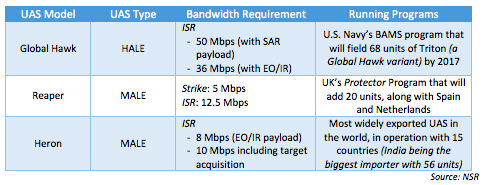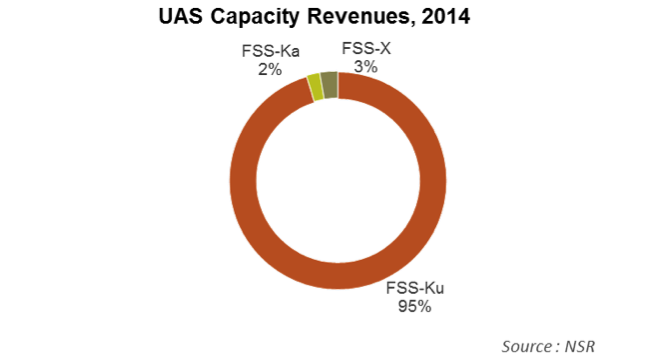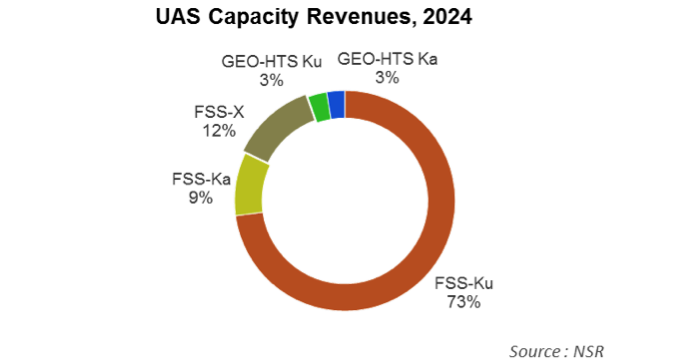UAS: SatCom Platinum Club Members
Nov 23rd, 2015
by Prateep Basu, NSR
The recent spate of human tragedies orchestrated by terrorist
organizations across the globe, from Paris to Mail, Beirut and
the Sinai, has made one thing clear: the world is readying up
for another long war. The key that defense planners tout
to maintaining the edge over the enemy is reliable Intelligence,
Surveillance, and Reconnaissance (ISR) capabilities. Unmanned
Aircraft Systems, or UAS, are now battlefield proven for ISR,
courtesy of the decade-long wars in Iraq and Afghanistan by the
U.S. and NATO forces, and their numbers have seen an
unprecedented increase during the same period, providing the
satellite communications industry a lucrative source of
revenues. The recent intensification of war in the Middle-East
and geopolitical tensions in the Asia-Pacific region prompted
the U.S. to increase
its UAS flights by 50% in the next two years,
and this is only the tip of the iceberg.
In 2011, when defense budget cuts
were made after U.S. and NATO troop pullout from Afghanistan and
Iraq, there was still a spark
in the gloomy defense and intelligence markets for Satcom
operators: UAS. The U.S.
Government kept funding UAS programs for its Navy, Air Force,
Army, and Homeland Security, with other nations realizing their
importance and funding or purchasing high performance HALE and
MALE UAS like the Global Hawk, Predator, and Reaper. These UAS,
capable of flying continuously for more than 24 hours at high
altitudes, have rapidly increased in their sophistication to
assist the forces in hunting and targeting enemies, providing
real-time high definition slow motion video, and for tactical
purposes. These trends point to a key question –
how much satellite bandwidth
do these machines require, and how much demand will they create
in the future?
UAS are ‘bandwidth-hungry’, partly due to payload needs and
partly due to the need for a reliable beyond-line-of-sight data
link for avoiding accidents. To meet such requirements, a good
link budget is needed that necessitates a high power two-way
signal. Thus, despite a
requirement of perhaps 4MHz only, up to 18 MHz of capacity may
need to be purchased for a single UAS flight operation.
In the table below, NSR summarizes the bandwidth requirements of
some of the popular UAS models in operation.

With almost 1,500 active
in-service UAS units currently (~40% operated by the U.S.
alone), and this number expected to more than double in the next
10 years, the
burgeoning bandwidth needs cannot be met by military satellites
communications (protected Milsatcom). The conflicts in Syria and
Iraq, which have spilled over to the many countries in the
Middle-East and Africa, in addition to their regional conflicts,
strengthens NSR’s belief that UAS and their Satcom demand has
nowhere to go but up.
Add to it the simmering situation in the South China Sea,
border conflicts in Asia and Eastern Europe, and U.S.
Government’s intense lobbying at the ongoing WRC-15 for
persuading global governments to allocate Ku- or Ka-band
satellite spectrum for command and control of UAS,
it can be said without a doubt
that UAS are here to stay.
Taking all such drivers and
constraints into consideration, NSR’s UAS Satcom & Imaging
Markets, 2nd edition report forecasts
global capacity demand will grow at a
CAGR of 9.3%, generating demand of 122 TPEs for FSS operators
and additional 33 Gbps of HTS capacity by the end of 2024.
The switch to cheap HTS capacity is however imminent, as
global coverage through Inmarsat’s GX and Intelsat’s EPIC
becomes available, and current ‘cost-effective’ solutions like
FSS Ku-band inclined satellite capacity slowly starts running
out of favor for supporting high bandwidth, requiring payloads
like Synthetic Aperture Radars, GMTI and Weather Radar. However,
this transition is expected to be slow as airborne Satcom
terminal retrofits are expensive and time taking affairs,
leading to FSS Ku-band maintaining its hegemony in this
market, with good gains made by FSS Ka
and X-bands over the forecast period.


Bottom Line
-
Defense and security needs are
pushing countries across the globe to invest in UAS
programs, which are expected to drive Satcom capacity demand
through this decade and provide opportunities for operators
to generate revenues.
- The bulk of this
demand is expected to arise in the Middle-East & Africa and
Asian regions due to armed conflicts and geo-political
tensions.
- Both FSS and HTS
capacity demand is expected to grow steadily till 2024 to
meet the bandwidth demands of these UAS, which keeps
increasing by the day, with Ku-band continuing as king of
this niche market.
Thus, interest from all over the world to adopt UAS in fleets
for carrying out ISR operations clearly implies – UAS are here
to stay and their growth will fuel Satcom bandwidth demand
throughout the next decade.